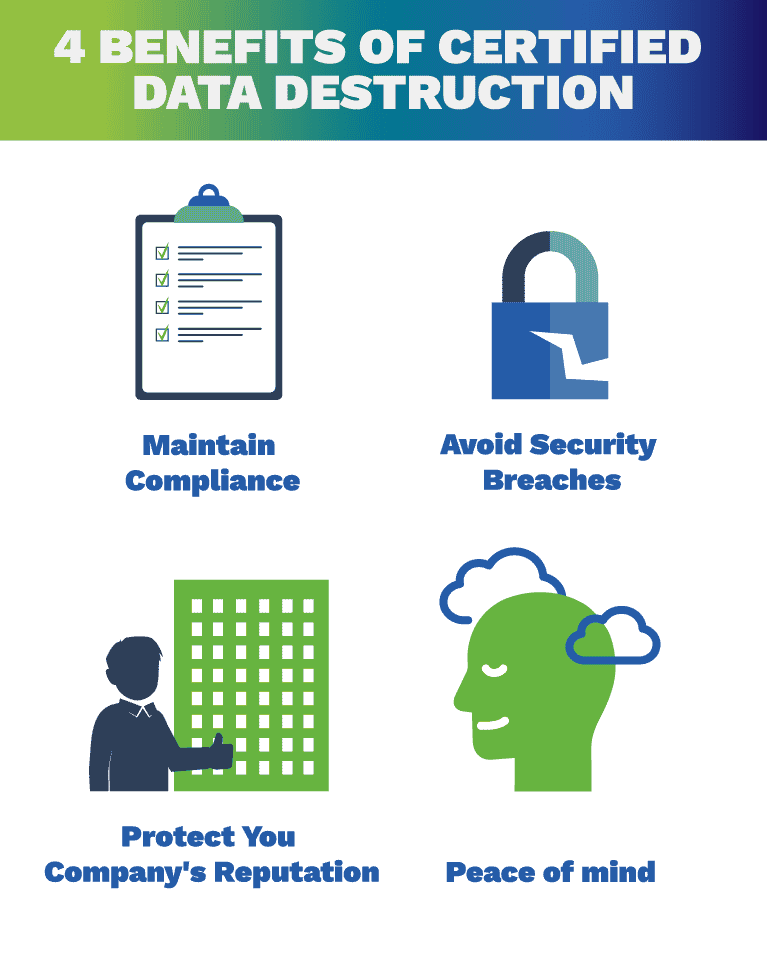Necessary Cyber Security Practices for Effective Data Destruction Strategies
Necessary Cyber Security Practices for Effective Data Destruction Strategies
Blog Article
The Relevance of Effective Information Destruction Practices in Safeguarding Sensitive Information and Ensuring Computer Safety
In a period where data breaches are increasingly typical, the relevance of effective data destruction practices can not be overstated. Implementing durable data destruction approaches not just alleviates these dangers however also aligns with lawful compliance demands, making sure that companies maintain their track record and foster customer trust.
Understanding Data Devastation
Comprehending information damage is crucial in today's electronic landscape, where sensitive information can conveniently be compromised. Efficient information damage involves not merely removing data yet guaranteeing that data is irretrievable via comprehensive methods. This process is vital for organizations that take care of confidential client info, copyright, or interior files, as any kind of violation can cause serious financial and reputational effects.
Data damage encompasses different techniques, including shredding physical media, degaussing magnetic storage space gadgets, and employing software-based solutions that overwrite data multiple times. Each method offers a particular function and must line up with the sensitivity of the information being disposed of. Physical destruction is commonly chosen for hard drives having highly personal data, while software techniques could be adequate for less sensitive details.
In addition, adhering to market standards and policies, such as the General Data Security Policy (GDPR) or the Medical Insurance Mobility and Accountability Act (HIPAA), is vital for conformity and to reduce legal threats. Organizations should develop a robust information damage policy, train workers on best methods, and frequently audit their treatments to guarantee that all delicate information is dealt with firmly and effectively.
Threats of Inadequate Practices
Inadequate data damage methods reveal companies to substantial risks that can have significant effects. When sensitive info is not effectively disposed of, it remains at risk to unapproved gain access to, which can lead to data violations and identity burglary. Such occurrences not only endanger the security of people yet likewise taint the company's reputation, causing a loss of consumer trust fund and possible economic consequences.
In addition, regulative conformity is progressively stringent in numerous industries. Failure to comply with data destruction laws can result in large penalties and lawsuits versus organizations. These fines can draw away and stress financial resources focus from core business operations.
In enhancement, the misuse of residual data can cause intellectual residential property burglary or corporate reconnaissance, threatening competitive advantages (data destruction). The impact of poor data destruction prolongs past instant financial losses; it can also cause long-lasting damage to brand honesty and market position

Organizations have to identify that information security is not only concerning protecting against breaches; it additionally encompasses the liable monitoring of data throughout its lifecycle. Neglecting effective data destruction methods can have tragic ramifications, underscoring the requirement for durable procedures to reduce these dangers.
Finest Practices for Information Destruction
Carrying out effective information destruction techniques is important for guarding delicate details and keeping compliance with regulatory standards. Organizations needs to take on a multi-faceted approach to make sure that information is irretrievable, thereby stopping unapproved accessibility and prospective breaches.
First, information should be categorized based on level of sensitivity, enabling companies to apply suitable damage approaches customized to the level of risk. For digital data, using software-based data-wiping devices that adhere to sector standards can efficiently overwrite existing information. Physical devastation techniques, such as shredding or degaussing, are important for gadgets that keep sensitive details, guaranteeing total obliteration.
Establishing a clear information retention plan is crucial, describing the length of time different types of details ought to be kept prior to devastation. Regular audits of information storage space systems are also necessary to determine unnecessary or outdated data requiring elimination.
In addition, training workers on the relevance of information destruction and the specific methods to follow fosters a culture of protection within the organization. Maintaining documents of information devastation refines provides accountability and supports compliance with external regulations and interior plans. By adhering to these ideal methods, organizations can dramatically alleviate the check this site out dangers linked with information direct exposure.
Legal and Compliance Considerations

Failure to abide with these regulations can lead to extreme fines, consisting of considerable fines and reputational damages. Organizations should implement a durable data devastation policy that aligns with these legal frameworks and gives clear standards on the proper methods of data disposal, whether physical shredding or electronic wiping.
Moreover, preserving paperwork of information damage tasks is essential for demonstrating compliance throughout audits or evaluations. By prioritizing legal and compliance considerations, organizations can enhance their information safety pose and foster count on with stakeholders and clients, ultimately adding to a much more secure information monitoring setting.
Benefits of Effective Information Devastation
Effective information damage methods extend past plain conformity; they use considerable advantages to organizations that prioritize them. By making sure that delicate info is irretrievably destroyed, organizations minimize the risk of information violations and the potential financial consequences associated with them. This proactive method not just safeguards versus unapproved accessibility but also improves the total dependability of the company in the eyes of stakeholders and customers.
Implementing robust data damage approaches, such as physical destruction of storage devices or advanced information cleaning techniques, adds to the strengthening of a company's see this page cybersecurity stance. data destruction. It minimizes the possibility of intellectual home burglary and shields proprietary details, consequently keeping an one-upmanship in the market

Final Thought
In final thought, reliable information damage methods are crucial for securing sensitive details and enhancing general computer security. By executing thorough methods such as software program, degaussing, and shredding overwriting, organizations can mitigate the dangers connected with unapproved access and data violations. Adherence to regulatory standards, consisting of GDPR and HIPAA, more reinforces compliance and shields versus legal repercussions. Eventually, a dedication to robust information damage techniques promotes a culture of responsibility, thereby reinforcing a company's cybersecurity position and maintaining customer trust.

Report this page